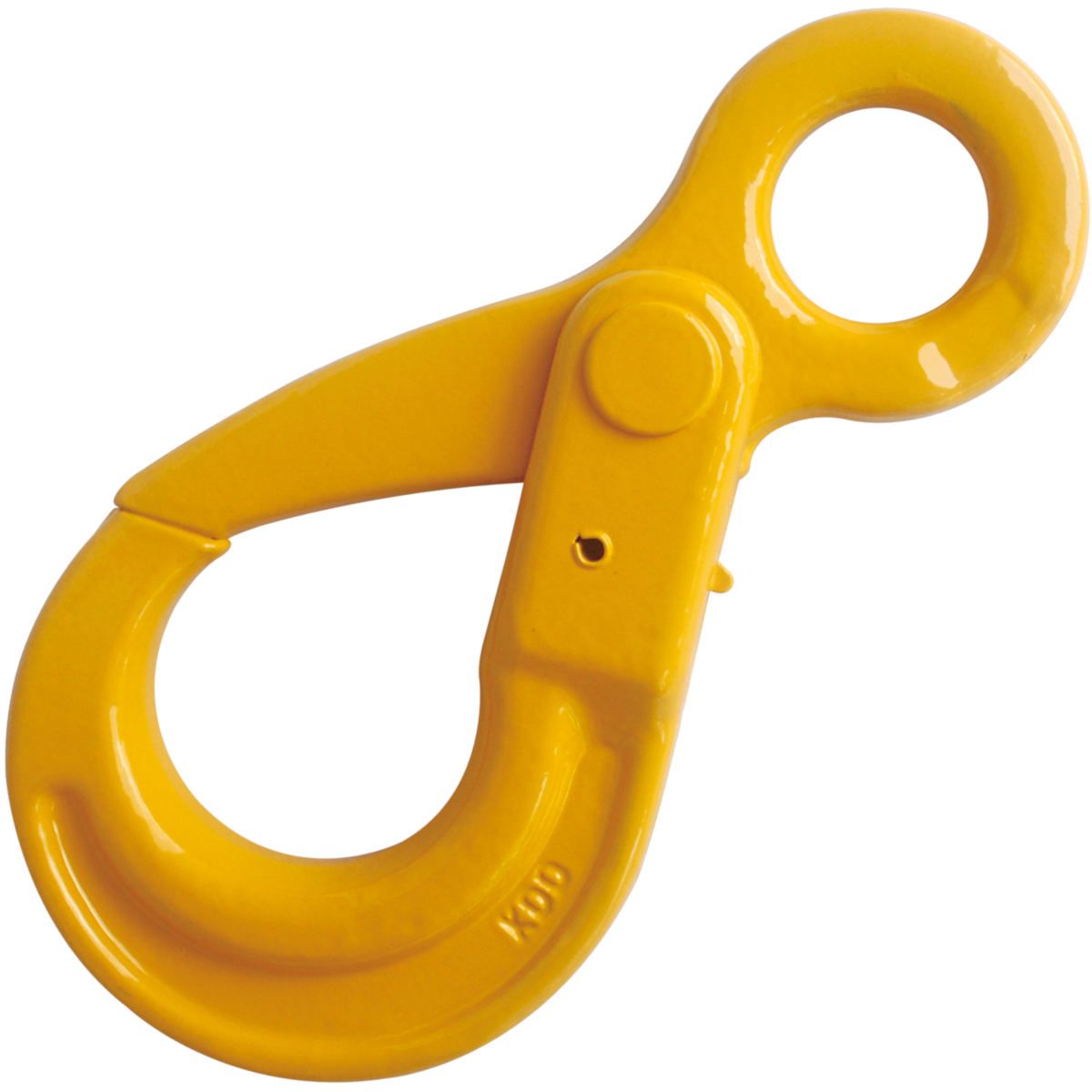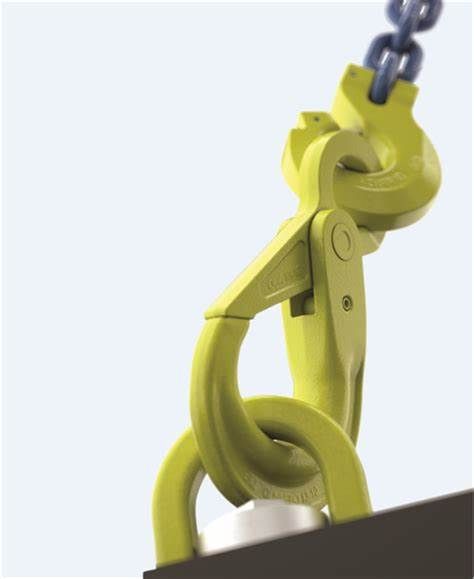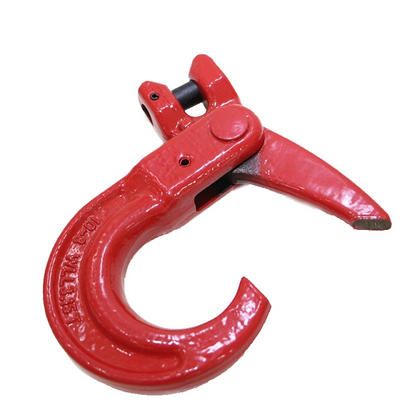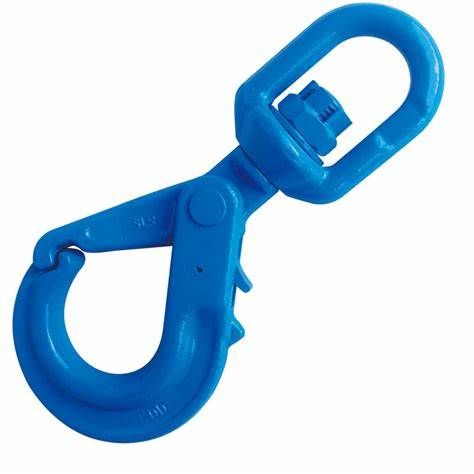1410, PARKSON, 44-60 ZHONGSHAN ROAD, QINGDAO, CHINA
Learn more about self-locking hooks
Self-locking hooksSelf-locking hooks, also commonly known as positive locking hooks or safety hooks, are used in all applications, from industrial manufacturing to offshore oil and gas. There are many clear benefits that end-users have found in switching from sling or standard hooks to self-locking hooks – all contributing to enhanced safety in their lifting operations.
Self-closing design

As the name suggests, self-locking hooks close by themselves as soon as a load is placed in the bowl of the hook and lifting begins. Once it closes, it cannot open again until the load is released from the hook.
The self-locking hook concept was launched as the BK model by the then Gunnebo Industries in the 1960s, primarily to improve safety on construction sites where, previously, hooks were being rigged without any latch at all.
Highly robust latch
Lifting in the construction industry has always been difficult as there is a lot of variability in the loads. Equipment also gets put through a lot of wear as many people are handling the lifting gear and lifting various objects, which often can result in damage to spring latches, like those on a sling hook. This either leads to the lifting gear being taken out of service, potentially delaying work on site, or if good lifting practices are not followed, people may use it without the latch leading to a hazardous lift. The more durable latch on a self-locking hook will last much longer and avoid this happening, while always remaining closed when under load.
Utilized in a broad range of applications
Without listing them all, here are three examples of applications where the safety benefits of using self-locking hooks are widely recognized and used:
 Construction: wire rope slings, chain slings, and as a connection point between a shackle (or hook) and a sling coming from an excavator.
Construction: wire rope slings, chain slings, and as a connection point between a shackle (or hook) and a sling coming from an excavator.
Industrial manufacturing: chain slings and we are also starting to see more hoists getting refitted with self-locking hooks.
Offshore: used in forerunners / stingers, which is the line that comes off the crane on the offshore platform to either move loads around the platform or from a supply vessel to the platform.
Self-Locking Hook Safety Information
1.Never use a hook without training.
OSHA regulation requires responsible work practices. “The employer shall permit only those employees qualified by training or experience to operate equipment and machinery.” OSHA 1926.20 (b) (4)
Employee training should include information given in OSHA training literature, ASME B30.9 “Slings” and ASME B30.10 “Hooks” safety standards and this document.
2.Always inform yourself and ask your employer for hook safe use instruction.
3.The maximum load applied to self-locking hooks must be known for proper self-locking hook selection.
4.Never use a hook without a legible product identifier.
5. Never overload a hook.
6. Never rig a hook to a load improperly and avoid dropped loads and hook damage.
Loads shall be centered in the base (bowl/saddle) of hook to prevent point loading of the hook.
Hooks shall not be used in such a manner as to place a side load or back load on the hook.
(When using a device to close the throat opening of the hook, care shall be taken that the load is not carried by the closing device.
Hands, fingers and body shall be kept from between hook and load.
The use of a hook with a latch does not preclude the inadvertent detachment of a slack sling or a load from the hook. Visual verification of proper hook engagement is required in all cases.
Chain sling WLL when choked with self-locking hooks equals 80% of sling identification tag WLL.
7. Never use a worn-out or damaged hook.
OSHA 1910.184(d) states, “Each day before being used, the sling and all fastenings and attachments shall be inspected for damage or defects by a competent person designated by the employer. Additional inspections shall be performed during sling use where service conditions warrant. Damaged or defective slings shall be immediately removed from service.”

Self-locking hooks: the history
In the early 1960s, Karl-Axel Wahlström and Stig Lindgren were credited for the first prototype, hand-carved out of wood—a simpler prototyping method than the 3D printing we use today. They called it the ‘BK’ hook, an abbreviation of ‘Byggnadskrok’, which in Swedish is a combination of the word ‘byggnads’, meaning construction, and ‘krok’, meaning hook. The product was patented and released to the market in 1965.
The BK and Crosby Shur-Loc hooks produced by The Crosby Group today are very similar, both are now designed to avoid fingers getting pinched when opening the hook, which is a common problem with lower quality hooks. Interestingly, the Crosby Shur-Loc and the Gunnebo Industries BK hook use different approaches to solving this issue. The Shur-Loc was designed with an enlarged thumb access, positioned further down and away from the pinch point, while on the BK hook, a latch rotation stop was introduced to stop the latch from pivoting down on the thumb.

Both may seem like small changes in the design but are extremely important in increasing the worker safety and minimizing downtime from accidents. Pinch point injuries are one of the most common injuries at worksites and designing a product that will help minimize that risk is critical. Other slight adjustments with big impact that have been made over the years include flat sections to allow connection with omega couplers or the GrabiQ system, recessed triggers, and easily replaceable trigger sets.
Today, The Crosby Group offers clevis self-locking hooks that connect directly to a chain sling; ball-bearing swivel hooks that can rotate under load; a Griplatch hook with a latch that connects to the body for improved side-stability and reduced weight; galvanized hooks for severe-weather protection; and even a special self-locking version for skip-loaders.
To further enhance the safety features of the hook, we have added the option of a handle to minimize the pinch risk when manipulating the hook. The handle was developed for high-risk environments such as helicopter lifts or lifts in offshore operations, where bad weather and swells are common.
Another invention that came from the offshore oil and gas industry was the Gunnebo Industries’ branded double latch hook. The secondary, spring-loaded latch acts as a redundant safety feature, making it impossible for the load to slip out, should the main latch come undone due to being violently hit while the load is idle, for example.
Learning more Self-locking hooks information, pls click below:
https://www.huahanmachinery.com/hook30.html